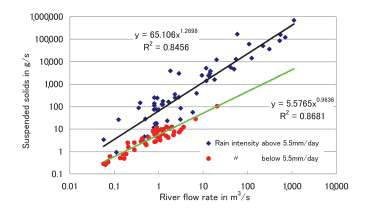Runoff of suspended solids, nitrogen and phosphorus estimated from catchment basins of Miyara River on Ishigaki Island
Description
[Objectives]
It is commonly known that large amounts of eroded red soil, which flow into the seacoast via rivers from agricultural fields and other various bare lands adversely affect natural ecosystems such as coral reefs and fisheries in the subtropical islands of Japan. Marine pollution, which is caused by nitrogen and phosphorus emitted from chemical fertilizers and animal wastes, have recently become an increased threat to the environment, particularly in these coastal areas. There is little data available on the actual amounts of suspended solids, nitrogen and phosphorus that flow into the island ecosystems. Therefore, concentrations of these chemicals and the flow volume of the Miyara River in Ishigaki Island were monitored for 3.5 years from May 1999 to December 2002.
[Results]
Total nitrogen concentrations were low in the upper reaches of the river and rose gradually with the decrease in distance from the river mouth (Fig. 1), most likely because many forests are located upstream, and the main sources of nitrogen, such as agricultural fields, are located downstream. In addition, the data in Fig. 1 implies that nitrogen pollution was brought about by animal husbandry practices; the results show higher total nitrogen concentrations at the Shinko Bridge near the river tributary, where a large livestock breeding complex is located, in comparison to the lower concentrations recorded at the Nakamizu Bridge, located upstream near paddy fields.
According to the results, there are direct correlations between the flow rate of suspended solids and river flow rate (Fig. 2), and between nitrogen flow rate and river flow rate. Thus, we were able to calculate the flow rates of suspended solids and nitrogen based on river flow rates and regression equations. Two regression equations were derived from data for the flow rates of suspended solids, with an upper threshold value of 5.5 mm /day rainfall.
The quantity of suspended solids, nitrogen and phosphorus, which flow through the Miyara River, into the seacoast per year were estimated to be 1882, 68 and 7 tons, respectively. Based on this data, 0.2 mm of surface soil are calculated to erode from agricultural fields in a period of one year, and 25 and 6% of the total amounts of nitrogen and phosphorus used in agriculture and discharged from livestock excretions will flow into Miyara River in one year.
Figure, table
-
Fig. 1. Changes in total N concentrations from the river mouth to the upper reaches of the Miyara River. -
Fig. 2. Relation between river flow rates and quantity of suspended solids.
- Affiliation
-
Japan International Research Center for Agricultural Sciences Okinawa Subtropical Station
- Classification
-
Technical A
- Term of research
-
FY2003 (FY1999-2002)
- Responsible researcher
-
BANZAI Kenji ( National Institute for Agro-Environmental Sciences )
NAKAMURA Ken ( Okinawa Subtropical Station )
KHONDAKER Nur Ahamed ( Bangladesh Agricultural Research Council )
- ほか
- Publication, etc.
-
Banzai, K. and Nakamura, K. (2003): Soil particles runoff from cultivated land water quality loading in river basin. Applies Hydrology (JSIDRE), 16, 38-45 (in Japanese).
- Japanese PDF
-
2003_28_A3_ja.pdf2.39 MB
- English PDF
-
2003_28_A4_en.pdf79.97 KB


